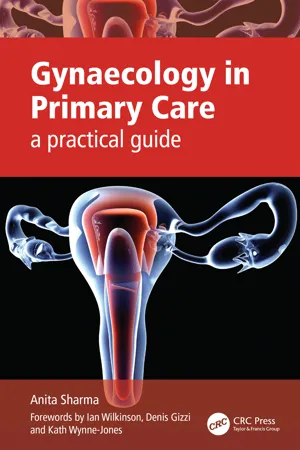
- 272 pages
- English
- ePUB (mobile friendly)
- Available on iOS & Android
About this book
Gynaecology in Primary Care comes at a time of great change in health service delivery. General practice is facing the challenges of developing Clinical Commissioning Groups, providing an ever greater range of primary care services and implementing NICE guidelines, whilst CCGs through their members will be under a legal duty to innovate. From a provider perspective, the book equips general practitioners with up-to-date knowledge of common gynaecological conditions, suggestions of best practice with regard to management and investigations to be undertaken within primary care, and guidelines for onward referral, where this is appropriate and necessary. From a commissioning perspective it provides an invaluable resource to CCGs, to inform their future pathways for gynaecology care. This highly practical book delivers the main aim of the RCP report - to ensure best care for female patients in the setting of their choice and where possible to develop streamlined one-stop services in primary care so that women do not have to take time off from their work and family commitments. It is ideal for general practitioners needing to be inspired and informed, and is also highly recommended for other healthcare professionals and medical students with an interest in women's health. 'Optimal patient care requires many connected features to synchronise effectively. This book describes how this could be achieved by focusing attention on well-crafted, evidencebased clinical pathways. This book advances our thinking on how we connect clinical, system and patient level perspectives on optimal care management.' Denis Gizzi, in his Foreword 'Written by a highly regarded, experienced and practicing GP, who has taken on the role as Clinical Director on behalf of the CCG for this programme area, this book is a valuable asset for both practicing GPs and developing CCGs to ensure that gynaecology services effectively commission, maximise the health of the population, improve the experience of the patient, and improve value for money.' Kath Wynne-Jones, in her Foreword 'An excellent guide to the management of gynaecological problems in primary care for not only clinicians in training, but for more experienced clinicians who look for straightforward and easily accessible advice to support their clinical management decisions. Look no further than this textbook. Dr Sharma's textbook will be a boon to developing organisations in delivering world-class services.' Dr Ian Wilkinson, in his Foreword
Frequently asked questions
- Essential is ideal for learners and professionals who enjoy exploring a wide range of subjects. Access the Essential Library with 800,000+ trusted titles and best-sellers across business, personal growth, and the humanities. Includes unlimited reading time and Standard Read Aloud voice.
- Complete: Perfect for advanced learners and researchers needing full, unrestricted access. Unlock 1.4M+ books across hundreds of subjects, including academic and specialized titles. The Complete Plan also includes advanced features like Premium Read Aloud and Research Assistant.
Please note we cannot support devices running on iOS 13 and Android 7 or earlier. Learn more about using the app.
Information
1
Dysmenorrhoea
Pathophysiology of primary dysmenorrhoea:

www.sogc.org/guidelines/public/169E-CPG-December2005.pdf
Prevalence
Risk factors
- smoking
- early menarche
- heavy menstrual bleed
- prolonged menstrual bleed
- strong family history
- obesity
- age (symptoms are more pronounced in adolescents than in older women)7
- lower socioeconomic groups4
- frequent lifestyle changes, less social support and stressful relationships.9
Primary care management
History
Menstrual history
Pain
Sexual history
Family history:
Table of contents
- Cover
- Title Page
- Copyright Page
- Table of Contents
- Foreword
- Foreword
- Foreword
- Preface
- About the author
- Acknowledgements
- 1 Dysmenorrhoea
- 2 Premenstrual syndrome
- 3 Menstrual migraine
- 4 Dyspareunia
- 5 Pelvic pain
- 6 Vaginal dryness
- 7 Vulvodynia
- 8 Management of vaginal discharge in primary care
- 9 Pelvic inflammatory disease
- 10 Dysfunctional uterine bleeding
- 11 Postmenopausal bleeding
- 12 Postcoital bleeding
- 13 Intermenstrual bleeding
- 14 Genital prolapse
- 15 Pessary service in NHS Oldham
- 16 Infertility
- 17 Female urinary incontinence
- 18 Urinary retention: a primary care emergency
- 19 Endometriosis
- 20 Menopause
- 21 Understanding gynaecological ultrasound scan
- 22 Polycystic ovary syndrome
- 23 Endometrial cancer
- 24 Uterine fibroids
- 25 Ovarian cancer
- 26 Colposcopy
- Index